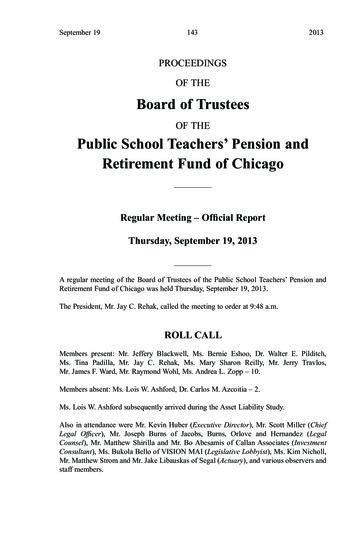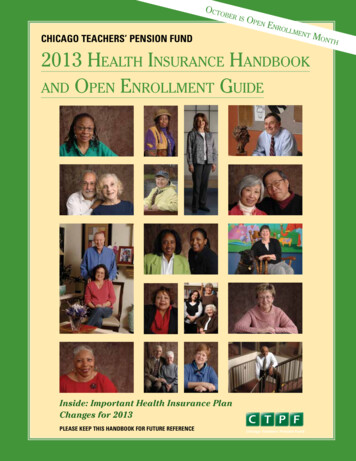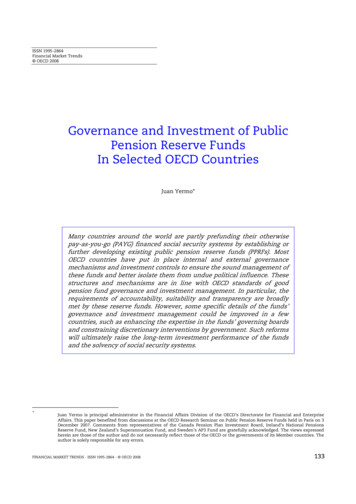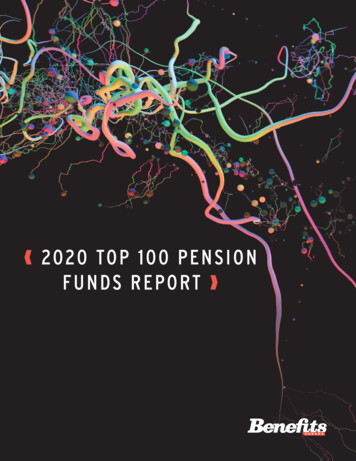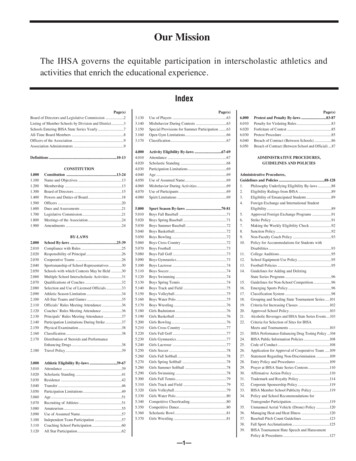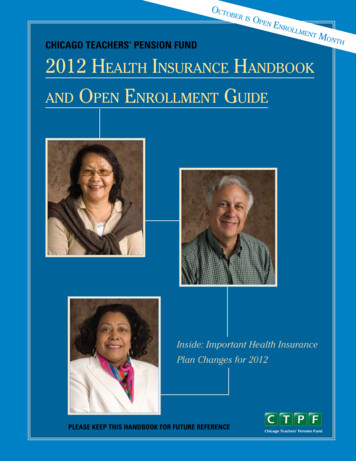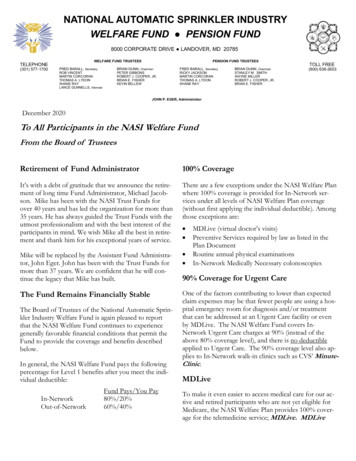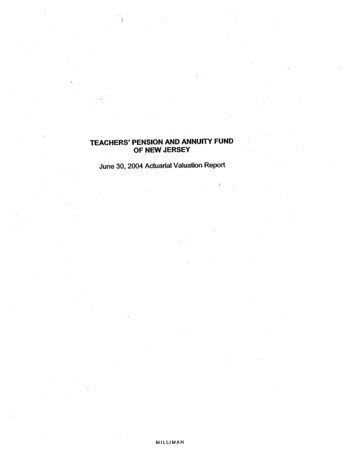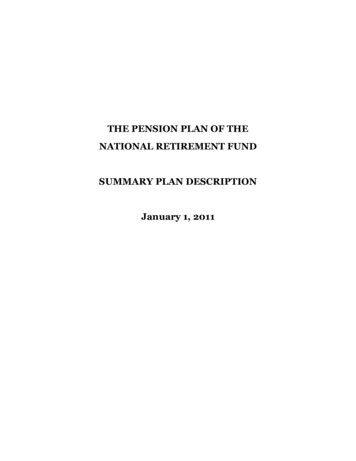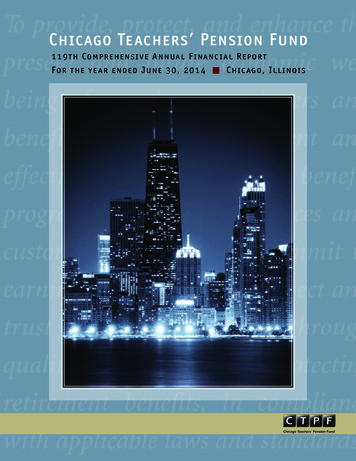
Transcription
To provide,protect,andenhancethChicago Teachers’ Pension Fundpresent and future economic webeing of members, pensioners anbeneficiaries through efficient aneffective management of benefiprograms, investment practices ancustomer service, and to commit tearning and keeping the respect antrust of the participants througquality service and by protectinretirement benefits, in compliancPwith applicable laws and standards119t h Compr ehen s i v e A nnual F i nanc i al Rep o r tF o r the ye ar ended Ju ne 3 0 , 2 0 1 4 n C h i c ago, Illi no i sChicago Teachers’ Pension Fund
119th Comprehensive Annual Financial ReportFor the year ended June 30, 2014Chicago, IllinoisPublic School Teachers’ Pension and Retirement Fund of ChicagoReport prepared by the staff of the Public School Teachers’ Pension and Retirement Fund of Chicago Introduction 1
Ta b l e o f C o n t e n t sINTRODUCTORY SECTION (UNAUDITED) PAGE 345689Board of TrusteesCertificate of Achievement for Excellence inFinancial ReportingConsultantsOrganizational ChartLetter of TransmittalFINANCIAL SECTION PAGE 1516 Independent Auditor’s Report18 Management’s Discussion and Analysis(Unaudited)Basic Financial Statements252627Statement of Fiduciary Net PositionStatement of Changes in Fiduciary Net PositionNotes to Financial StatementsRequired Supplementary Information444546464747Schedule of Changes in Employer’s NetPension Liability (Unaudited) – Pension PlanSchedule of the Employer’s Net PensionLiability (Unaudited) – Pension PlanSchedule of Employer’s Contribution(Unaudited) – Pension PlanSchedule of Money-Weighted Rate of Return(Unaudited) – Pension PlanSchedule of Funding Progress (Unaudited) –Health Insurance PlanSchedule of Employer Contributions (Unaudited) –Health Insurance PlanNotes to Required Supplementary Information48Actuarial Methods and Assumptions Pension andHealth Insurance PlanOther Supplementary Information49505051Administrative and Miscellaneous ExpensesSchedule of Cash Receipts and DisbursementsSchedule of Manager FeesSchedule of Consultant PaymentsINVESTMENT SECTION (UNAUDITED) PAGE 52535455565758596061626364656667Master Custodian ReportInvestment Consultant ReportReal Estate Consultant ReportTotal Annual Fund Rate of ReturnSchedule of Investment ResultsInvestment Portfolio SummaryAsset Allocation SummaryHistorical Asset AllocationDomestic Equity SummaryInternational Equity SummaryInternational Equity HoldingsFixed Income SummaryPublic REITs SummaryPrivate Equity SummaryInfrastructure Summary6768697074Hedge Fund SummaryReal Estate SummaryManager AnalysisBroker Commission ReportsInvestment AuthorityACTUARIAL SECTION (UNAUDITED) PAGE 7576Actuarial CertificationPension Actuarial Report, Pension FundExhibit A: Table of Plan CoverageExhibit B: Participants in Active ServiceExhibit C: Reconciliation of Participant DataExhibit D: Schedule of Retirees and BeneficiariesAdded to and Removed from RollsExhibit F: Schedule of Average Benefit PaymentsExhibit G: Summary Statement of Income andExpenses on a Market Value BasisExhibit H: Summary Statement of Plan PositionExhibit I: Development of the FundExhibit J: Development of Unfunded ActuarialAccrued LiabilityExhibit 1: Summary of Actuarial Valuation ResultsExhibit 2: Comparison of Employer Contribution toActuarially Determined ContributionExhibit 3: Schedule of Funding ProgressNet Pension LiabilitySchedules of Changes in Net Pension LiabilityExhibit 5: Actuarial Assumptions andActuarial Cost MethodExhibit 6: Summary of Plan ProvisionsExhibit 7: Definitions of Pension TermsHealth Insurance Fund115 Actuarial Report Health Insurance115 Exhibit A: Summary of Participant Data116 Exhibit B: Actuarial Accrued Liability (AAL) andUnfunded AAL (UAAL)117 Required Supplementary Information118 Exhibit 1: Actuarial Assumptions and ActuarialCost Method123 Exhibit 2: Summary of the Plan124 Exhibit 3: Definitions of Terms125 Exhibit 4: Accounting RequirementsSTATISTICAL SECTION (UNAUDITED) PAGE 126127 Statement of Changes in Fiduciary Net Position,Pension Fund129 Statement of Changes in Fiduciary Net Position,Health Insurance Fund131 Distribution of Current Annuitants by Benefit Type132 Distribution of Pensioners with Health InsuranceReimbursements by Size of Annuity133 Schedule of Average Benefit Payments134 Number of Active Members
Introduct ionThis section provides information regarding the ChicagoTeachers’ Pension Fund Board of Trustees and its consultants, anorganizational chart, a Certificate of Achievement, a Letter ofTransmittal, and additional administrative information. Introduction 3
Board of TrusteesAs of June 30, 2014OFFICERSPresident, Jay C. RehakVice President, Lois W. AshfordFinancial Secretary, Mary Sharon ReillyRecording Secretary, Raymond WohlJay C. RehakLois W. AshfordMary Sharon ReillyRaymond WohlMEMBERSRepresenting the ContributorsLois W. AshfordJeffery BlackwellBernie EshooTina PadillaCarlos M. AzcoitiaRobert F. BuresJeffery BlackwellBernie EshooJay C. RehakRaymond WohlRepresenting the AnnuitantsRobert F. BuresWalter E. PilditchMary Sharon ReillyTina PadillaWalter E. PilditchJerry TravlosAndrea L. ZoppRepresenting the Administrators/PrincipalsJerry TravlosRepresenting the Board of EducationCarlos M. AzcoitiaAndrea L. ZoppExecutive Staff4Executive Director,Kevin B. Huber Introduction
Introduction 5
ConsultantsAs of June 30, 2014LEGAL COUNSELJoseph BurnsJacobs, Burns, Orlove, and Hernandez150 North Michigan, suite 1000Chicago, Illinois 60601INVESTMENT CONSULTANTSGwelda Swilley-Burke and Matthew ShirillaCallan Associates Inc.120 North LaSalle Street, suite 2100Chicago, Illinois 60602Robert KochisThe Townsend GroupSkylight Office Tower1660 West Second Street, suite 450Cleveland, Ohio 44113HEALTH INSURANCE CONSULTANTPaul HillingAon Hewitt200 East Randolph Street, suite 900Chicago, Illinois 60601BANK CUSTODIANKathryn M. StevensonThe Northern Trust Company50 South LaSalle StreetChicago, Illinois 60675AUDITORSIrene DavisPartnerMitchell & Titus, LLP333 West Wacker DriveChicago, Illinois 60606CUSTODIANStephanie D. NeelyCity Treasurer121 North LaSalle StreetChicago, Illinois 60602CONSULTING ACTUARYKim NichollThe Segal Company101 North Wacker Drive, suite 500Chicago, Illinois 606066 Introduction
ConsultantsAs of June 30, 2014Adams Street Partners, LLCLazard Asset Management, LLCAdelante Capital Management, LLCLeading Edge Investment Advisors, LLCAriel Capital Management, LLCLM Capital Group, LLCAttucks Asset Management, LLCLombardia Capital Partners, LLCBlackstone GroupMacquarie GroupBMO Global Asset ManagementMesirow Financial, Inc.Capri Capital Partners, LLCMorgan Stanley Investment Management, Inc.CB Richard Ellis Investors, LLCMuller and Monroe Asset Management, LLCCenterSquare Investment Management, Inc.Newport Capital Partners Holdings, LLCChanning Capital Management, LLCPalladium Equity Partners, LLCCityViewPantheon Ventures, LLPDeutsche Asset & Wealth Management, LLCPharos Capital Group, LLCDimensional Fund Advisors, LTDPluscios Management, LLCDuPont Capital ManagementProgress Investment Management, LLCEarnest Partners, LLCPrudential Investment Management, Inc.Europa Capital Partners LLPPugh Capital Management, Inc.Fortress Investment Group, LLCRhumbLine Advisers, LPFranklin Templeton Real Estate Advisors, LLCSyncom Venture Partners, LLCFremont Realty Capital, LPTaplin, Canida and Habacht, Inc.Garcia, Hamilton & Associates, LPTCB-Broadway, LLCGreystar Equity Partners VII, LPThe Northern Trust CompanyHarbourVest Partners, LLCUBS Realty Investors, LLCHispania Capital Partners, LLCUrban America Advisors, LPHolland Capital Management, LPWaddell & Reed Asset Management GroupHudson Realty Capital, LLCWalton Street Capital, LLCICV Capital Partners, LLCWestern Asset Management Co.Intercontinental Real Estate Corp.William Blair & Company, LLCJ.P. Morgan Fleming Asset Management, Inc.Zevenbergen Capital Investments, LLCLaSalle Investment Management, Inc. Introduction 7
Organizational ChartAs of June 30, 2014Board of TrusteesRobert JurinekInternalAuditorKevin B. HuberExecutive DirectorMary Cavallaro, R.N.Senior Director ofBenefits8CarmenHeredia-López, CFAChief InvestmentOfficerKas Henry, Ph.D.Chief FinancialOfficerJerry BakerEdgar SamayoaSaron TegegneHealth BenefitsManagerBenefits ManagerAccountingManager Introduction Eric MorelInformationTechnologyManagerFrances RadencicDirector of Memberand Office ServicesSheronBanks-FallisMember ServicesManager
203 North LaSalle Street, suite 2600Chicago, IL 60601-1231LetterofTransmittalDecember 11, 2014The Pension Board of Trustees and Fund MembersPublic School Teachers’ Pension and Retirement Fund of Chicago203 North LaSalle Street, suite 2600Chicago, Illinois 60601Dear Pension Board of Trustees, Contributors, Pensioners, and Members of the Public:This is the 119th Comprehensive Annual Financial Report of the Public School Teachers’ Pension andRetirement Fund of Chicago (Fund) that covers the fiscal year ended June 30, 2014. Illinois statutesprovide for a Board of Trustees to be responsible for the administration of the Fund. An important aspectof the administration is the presentation of a detailed annual report of system finances and operations.This publication is intended for all parties-at-interest as well as for the public at large.The financial statements and their content are the responsibility of the Fund’s management. This reportprovides a review of the financial, investment, actuarial, and operational conditions of the Fund. Itcontains financial statements with some comparative data, which were subject to an independent auditconducted by Illinois licensed certified public accountants, an actuarial valuation prepared by the Fund’sconsulting actuary, a description of benefits as specified in Illinois law, and other relevant information.The Fund is a public employee retirement system established by the State of Illinois to provide annuity,disability, survivor, death, and health benefits for certain certified teachers and other employees of theChicago Public Schools and approved City of Chicago charter schools. It is administered in accordancewith Chapter 40, Act 5, Articles 1, 17, and 20 of the Illinois Compiled Statutes.OVERVIEWThe Fund’s membership increased to 63,194 members as of June 30, 2014, reflecting 0.4% growth overprior year membership of 62,911. The 119th year of continuous operations ended with the Fund’sfinancial condition reflecting an increase over the prior year. This was due to strong investment returnsand the employer making the actuarially required contribution for the fiscal year. The June 30, 2014,value of net assets held in trust for pension and health benefits amounted to 10.9 billion, an 11.8%increase from the 9.7 billion of the previous year.The actuarial value of assets of the Pension Fund, calculated on a 4-year smoothed market value basisand used in the determination of the funding ratio, amounted to 10.0 billion. A comparison of theactuarial value of assets to the actuarial accrued liabilities of 19.5 billion yields a 51.5% actuarialfunding ratio, an increase from the 49.5% funding ratio of June 30, 2013.The actuarial value of assets of the Health Insurance Fund amounted to 36.0 million. A comparison ofthe actuarial value of assets to the actuarial accrued liabilities of 1.9 billion yields a 1.9% actuarialfunding ratio, a 26.7% increase from the prior year funding ratio of 1.5%.The Financial Statements in this report were prepared in accordance with generally accepted accountingprinciples as promulgated by the Governmental Accounting Standards Board. The specific accountingtreatment of transactions is described in the Summary of Accounting Policies in the Notes to theFinancial Statements. We encourage readers to consider additional financial information in thisintroductory section, and in the overview and analysis sections of management’s discussion and analysisof the financial report. Introduction 9
INVESTMENT AUTHORITY AND PERFORMANCEThe Trustees’ investment authority is found in the Illinois Compiled Statutes, Chapter 40, Act 5, Articles 1and 17. A discussion of the specific investment authority, policy provisions, diversification posture,performance objective, and asset allocation is provided in the Investments Section of this report.As of June 30, 2014, investments at fair value plus cash and receivables totaled 11.2 billion reflecting a14% increase from the 9.8 billion value of June 30, 2013. The Fund’s investment performance for theone-year and ten-year periods ended June 30, 2014, was 18.4% and 7.3% respectively. Refer to theInvestments Section of this report for more detailed performance information.The Board of Trustees, with the aid of the CTPF investment staff and investment consultants, makedecisions under the prudent person rule authorized by Article 1 of the Illinois Pension Code. The Boardapproves an asset allocation program designed to obtain the highest expected return on investmentsconsistent with an acceptable level of risk for a large public employee retirement system. The Board relieson CTPF investment staff and investment consultants to monitor and evaluate the investmentmanagement firms’ performance, to aid in the selection of investment management firms and to assist inthe development of investment policy. Opportunities to improve the financial strength of the Fund willcontinue to be explored in accordance with the prudent person standard. Refer to the Manager Analysisand Broker Commission Report in the Investments Section of this report for information regardinginvestment management firms and brokerage firms that provide services to the Fund.ACCOUNTING SYSTEM AND INTERNAL CONTROLSThis report was prepared to conform to the principles of governmental accounting and reporting aspronounced by the Governmental Accounting Standards Board and the American Institute of CertifiedPublic Accountants. The accrual basis of accounting was used to record the assets, liabilities, revenuesand expenses of the Fund. Revenues are recognized in the accounting period in which they are earned,without regard to the date of collection, and expenses are recorded when the corresponding liabilities areincurred, regardless of when payment is made.The Fund began its accounting system upgrade in FY 2014 to proactively prepare and be ready to meet thenew GASB 67 and 68 requirements along with the necessary operational integrations. These efforts willcontinue through FY 2015 until all requirements are met for the FY 2015 reporting.In developing the Fund’s accounting system, consideration is given to the adequacy of internalaccounting controls. Although these controls are designed to provide reasonable assurance regarding thesafekeeping of assets and the reliability of financial records, the Fund continues to recognize that theanticipated costs should not exceed the projected benefits. Constant effort is directed by the Fundadministration towards improving the level of internal accounting control to ensure the members of theFund belong to a financially sound retirement system.ECONOMIC REVIEWThe fiscal year ending June 30, 2014, witnessed continually improving economic conditions, recordreturns in the equity market and a benign inflationary environment. News headlines during the firstquarter of the fiscal year were dominated by the continued impact of the May 22, 2014, release of FederalReserve meeting minutes indicating that a “tapering” of bond purchases (quantitative easing) mightbegin as soon as July and concerns about how the “taper” might impact the U.S. economic recovery.Disappointing earnings news from Walmart and Cisco in August 2013, coupled with the possibility of amilitary strike in Syria added to levels of uncertainty in the U.S. As the first quarter of fiscal year 2014marched on, the looming budget battle in Washington rattled markets through August. Markets stabilizedin September, as Russia stepped in to craft a potential solution to the situation in Syria and the Fedannounced that there would be no “taper” in the near term.News headlines were dominated by the continued speculation on whether the Fed would begin unwindingits asset purchase program during the second quarter of fiscal year 2014. In mid-September, the Fedannounced that the quantitative easing program would continue on, spurring a surge in non-U.S.securities during the quarter. The Fed’s decision in mid-December to taper its quantitative easingprogram, coupled with a resolution to the governmental shutdown in the U.S., contributed positively10 Introduction
to equity returns due to increased transparency and the elimination of speculation. As for emergingmarkets, solid returns in October contributed to positive returns for the quarter, although returns fell inNovember and December. Natural disasters in the Philippines and scattered political crises, most notablyin Thailand and Turkey, began to be causes for concern within emerging markets as the quarter cameto a close.During the third fiscal quarter, economic data were weaker than expected due largely to a very cold andsnowy winter, coupled with a significant drought affecting the West Coast of the United States. Inaddition, devaluations in several emerging markets’ currencies, concerns over a slowdown in China andthe unfolding crisis in Ukraine also weighed on investor sentiment. Furthermore, the combination of adecelerating Asia, high profile elections in late March and an anemic European recovery troubledinvestors and contributed to market volatility. The world’s emerging economies captivated most investorsin the beginning of 2014 as labor disputes consumed Russia and frontier market Ukraine. China alsounderperformed as economic growth skidded to an 18-month low.GDP growth was revised sharply downward from 0.1% to -2.9% during the third fiscal quarter, the largestcontraction in GDP since the Great Recession. This did not seem to affect economic activity, however, asGDP growth came in at a robust 4% for the quarter ended June 30, 2014. Consumption, inventory growth,exports, building activity and state and local government spending all contributed positively to results.However, the recovery continued to be uneven and geopolitical risks mounted. As a result, interest ratescontinued to drop (particularly long yields) and the yield curve flattened as the fiscal year came to aclose. As reported by the Bureau of Labor Statistics, the unemployment rate dropped to 6.1%, the lowestrate since 2008. The month of June marked the best five-month stretch of job creation since early 2006.ECONOMIC OUTLOOKThe improving U.S. economy has put upward pressure on interest rates, but geopolitical tensions insome regions of the world, coupled with a significant yield-advantage relative to other developedmarkets, has helped to dampen this effect. Foreign investors were lured to the relatively high yields inthe U.S. market, propelling the dollar sharply higher. At the end of the first quarter of fiscal year 2015,U.S. Treasuries offered a 57 basis points (bp) premium over German bunds (a 15-year high) as investorsweighed the prospects of U.S. interest rate hikes against the likelihood of a more accommodative policyin the euro zone.While the U.S. economy gained traction, news from Europe and Japan was more dismal, with euro zoneGDP barely positive during the last fiscal quarter versus a U.S. reading of over 4%. The ECB cut rates torecord lows in September 2014 to spur growth and stave off deflationary pressures. Germany’s economyshrank 0.2% during the quarter and euro zone inflation fell to 0.3% in September; the weakest in 5 yearsand well below target. Japan’s economy suffered its worst contraction since 2009 with negative GDPgrowth for the quarter (-7%) due, in part, to the implementation of sales tax increases from 5% to 8%.Equity valuations remain moderate on a historical basis with the S&P trading at 15.2x forward earnings;just below the 25-year average of 15.6x. Coincidentally, the S&P 500 peaked at 15.2x in the fall of 2007just before the start of the Great Recession. Foreign equities are relatively more attractive on a valuationsbasis as developed markets stand at 13.9x forward earnings while emerging markets are at 10.8x.Financial markets have entered a period of heightened uncertainty. While the U.S. economy has gainedtraction in recent periods, results in Europe and Japan have been far bleaker. Weak growth in Europe,Japan, and much of the developing world threatens to disrupt the global economic recovery. Equitieshave sold off and volatility expectations have spiked as evidenced by the Volatility Index (VIX) jumping tolevels not seen since late 2012. U.S. economic conditions appear stable, yet growth expectations arebeing trimmed. Inflationary fears have tempered in the U.S. while Europe is struggling to fend offdeflationary concerns and Japan continues to try to manufacture whatever inflation it can. Introduction 11
FUNDING GOALSThe funding policy of the Fund provides for employer contributions which, when added to contributionsreceived from employee members and earnings on investments, will be sufficient to meet the actuariallydetermined obligations of the Fund.On an annual basis, an actuarial valuation is performed in order to determine the amount of requiredcontributions in accordance with the Illinois Compiled Statutes (Public Act 89-15).The Chicago Board of Education (employer) is required by law to make contributions to the Fund in orderto ensure the actuarial value of assets is 90% of the actuarial value of liabilities by the end of apredetermined funding period. In years where the funding ratio exceeds 90%, no employer contributionis required.Amendments to the Illinois Pension Code during fiscal year 2010 changed the funding requirements forfuture years. Illinois Compiled Statutes (Public Act 96-0889) limited the contributions required to bemade to the Fund by the Chicago Board of Education to 187 million for fiscal 2011, 192 million forfiscal 2012, and 196 million for fiscal 2013. Under the amended statute, the Chicago Board of Educationwas provided a 14-year extension, or until the end of 2059, to make contributions which ensure that theFund’s projected actuarial value of assets is 90% of the Fund’s projected actuarial liabilities. For fiscal2014, the required contribution was 600 million. The employer is also required by law to fund over 680million in employer contributions for fiscal year 2015 and 675 million in fiscal year 2016. Historically,the employer has achieved significant funding reductions through legislative measures, most recentlyas 2010.In addition, the Illinois Compiled Statutes (Public Act 90-582) provide that the Chicago Board ofEducation (employer) and the State of Illinois (State) are required to make additional contributions as apercentage of payroll to offset a portion of the cost of benefit increases enacted under Public Act 90-582.MAJOR INITIATIVESThe Fund and its Trustees continue to work to enhance the Fund’s investment program, strengthen theFund’s benefits, improve office operations, and safeguard the assets of the Fund.INVESTMENTSThe Fund’s rate of return for the year ended June 30, 2014, was 18.4% as performance of the portfoliomirrored the strong equity markets. The Fund maintained a diversified portfolio consisting of equities(domestic and international), fixed income, real assets and alternative investments. The Fund continuedto attempt to maximize investment performance while maintaining acceptable levels of risk.The Board started and is in the midst of implementing its policy target allocation. The Board’s new policytargets are global equity at 61% (comprised of domestic equity at 29%, international equity at 29% andprivate equity at 3%); fixed income at 23%, real assets at 14% (comprised of private real estate at 7%,REITS at 2%, infrastructure at 3%, commodities at 2%); diversifying assets at 2%.During the year, the Board and staff performed due diligence over its investment managers in order tomonitor performance and compliance. The Fund continued its formal manager performance reviewprocess in order to monitor managers in all asset classes. During the year ended June 30, 2014, the Fundincreased its commitment to two existing private equity fund-of-funds managers and two existingminority-owned private equity fund managers. In the real estate asset class, the Fund initiatedinvestments with two industrial focused private real estate managers. One of the private real estatemanagers is minority owned. The Fund continues to be committed to diversity and as of June 30, 2014,approximately 33% ( 3.6 billion) of the Fund’s assets were managed by qualified minority, women anddisabled person owned investment managers. Additionally, the Fund directed 35% ( 1,472,401) ofcommissions to qualified minority, women and disabled owned broker dealers.The Fund issued a Custodial Services RFP and performed a robust review process in FY 2014 to select acustodial bank with treasury services and a security lending agent for a FY 2015 transition.12 Introduction
LEGISLATIVEThe Fund successfully sought passage of legislative changes to establish the rules for delinquentpayroll contribution, for data and cash on a pay period basis, which went into effect August 16, 2013,under PA 98-0427. The passage of this bill resulted in: n Improving timing of funding via the use of late fees and fines when employers delay transmittal ofwithheld employee contributions n Requiring all Charter Schools to have a designated Pension Officer who owns the pension fundingcomplianceAdditional legislative measures that affected the Fund include: n Public Act 98-0680: State funding for CTPF is statutorily required when the funded ratio is below90%; if and when that happens the State must pay .544% of the Fund’s teacher payroll. The lawappropriated 12.1 million in funding to CTPF for FY 2015. n Public Act 98-0675: Appropriated 50.0 million to CTPF for FY 15. State funding for CTPF ishistorically provided through two line items: one containing an appropriation that the Statehistorically contributes and a second line added in FY99 when the State statutorily is required topay .544% of the Fund’s teacher payroll if the funded ratio is below 90%. This 50.0 million forFY15 represents the first line item, which has not been appropriated since FY 11. n Public Act 98-1022: Beginning January 1, 2015, no contract for investment or consulting servicesor commitment to a private market fund shall be awarded by a retirement system, pension fund orinvestment board unless such entity first discloses the following: The number and percentage of its investment and senior staff who areminority, female, or disabled; The number of contracts with a minority owned business, female ownedbusiness, or business owned by a person with a disability; The number of contracts with businesses other than a minority ownedbusiness, female owned business, business owned by a person with adisability, if more than 50% of the services under that contract are performedby a minority person, a female, or a person with a disability; The law mandates that a retirement system must consider such information(within the bounds of financial and fiduciary prudence) before awarding acontract for investment services, consulting services, or commitment to aprivate market firm; In addition, if an investment firm meeting the system’s criteria responds to anRFP for investment services and meets the definition of a minority ownedbusiness, then that firm shall be allowed to present to the board before a finaldecision is made for that RFP; Finally, the law codifies that the boards of the Illinois retirement systemsshall establish goals for utilization of investment managers that meet thedefinition of minority owned business, female owned business, and disabledperson owned business. The systems will set a goal for each category.During the year, the Trustees and Fund Administrators have diligently exercised their fiduciaryresponsibilities and vigorously opposed legislative changes that negatively impact the financial stabilityand future of the Fund. The Trustees and Fund Administrators, in conjunction with the Fund’s consultants,continue to work in Springfield to represent the interests of the members and maintain the financialstability of the Fund. Introduction 13
OPERATIONSFund management continued to focus on strengthening operations, improving internal controls,modernizing key infrastructure components of the Fund, and emphasizing customer service for ourmembers.The fiscal year 2014 audit work was conducted by Mitchell & Titus LLP. The fiscal year 2014 actuarial workwas done by Segal.The Fund continued to work with its primary employer, Chicago Public Schools, to resolve payroll systemissues that impacted pension fund data while establishing a robust process to work with the growingCharter School employers.The Fund’s Executive Director, Kevin B. Huber, began a medical leave in May 2014. The Board of Trusteessubsequently appointed CTPF's President Jay C. Rehak, interim executive director, to provide leadershipat the Fund through August 2014. President Rehak returned to his teaching position in August and theBoard of Trustees then named Peter A. Driscoll, interim executive director on August 21, 2014.The Board has supported the administrative staff and is committed to moving into an automated workenvironment and organizational structure that will continue the Fund’s long history of superior customerservice. Detailed discussion regarding all of the Fund’s financial operations is found in the Management’sDiscussion and Analysis section of the Financial Report.AWARDSThe Government Finance Officers Association of the United States and Canada (GFOA) awarded aCertificate of Achievement for Excellence in Financial Reporting to Public School Teachers’ Pens
46 Schedule of Money-Weighted Rate of Return (Unaudited) - Pension Plan . Aon Hewitt 200 East Randolph Street, suite 900 Chicago, Illinois 60601. BANK CUSTODIAN. . The actuarial value of assets of the Pension Fund, calculated on a 4-year smoothed market value basis and used in the determination of the funding ratio, amounted to 10.0 .
